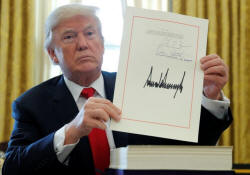In possible boon for White House, Fed ready to lay low
as tax plan kicks in
 Send a link to a friend
Send a link to a friend
 [January 08, 2018]
By Howard Schneider and Jonathan Spicer [January 08, 2018]
By Howard Schneider and Jonathan Spicer
PHILADELPHIA (Reuters) - U.S. Federal
Reserve policymakers have come to view Donald Trump's tax overhaul as a
short-term economic boost that will neither permanently supercharge the
economy, as the president says, or cause an immediate disruption that
would require a central bank response, as some analysts have warned.
That view emerged in recent interviews with four central bankers across
the policy spectrum, from those eager to keep interest rates low, to
those more inclined to raise rates as a guard against asset bubbles or
any unexpected inflation jolt.
The interviews offer the most detailed look yet at a key issue --
whether the changes in the tax code might prompt the Fed to raise rates
more quickly and thus blunt the new law's impact. The issue has divided
analysts, with even staff at Congress' Joint Committee on Taxation
assuming an "aggressive" Fed reaction to the new law.

But all four of those interviewed by Reuters shared a common conclusion
that the law would provide some short-term benefit without raising any
near-term risks.
They predict that the combination of corporate and household tax cuts
will raise growth by up to half a percentage point annually for the next
couple of years, and help keep unemployment at near record lows and thus
perhaps raise wages.
In addition, depending on how companies respond in terms of increased
investment, the plan might raise long-run potential growth by a small
amount.
What they do not see is any great risk that the tax stimulus will fuel
inflation or a run-up in asset prices that would prompt the Fed to raise
interest rates any faster than it already plans. Though not an
endorsement of the legislation, it is an important sign the Fed will not
stand in its way.
"I don't feel any urgency to do something preemptively," Federal Reserve
Bank of Cleveland President Loretta Mester said in an interview with
Reuters on the sidelines of the American Economic Association annual
conference in Philadelphia.
Mester has been among those more inclined to lift rates from crisis-era
levels, but sees no reason to rush because of the tax overhaul, which
she predicts will raise annual growth as much as a half a percentage
point for the next few years.
The Federal Reserve's most recent economic projections forecast three
interest rate rises in 2018. Market pricing currently indicates two.
Some private-sector economists recently penciled in four rises, partly
because of the tax plan's impact and how it might affect the Fed.
Central bankers, however, seem poised to stick with their current plans,
confident that inflation will stay tame and that the recent record run
on U.S. stock markets is largely the result of economic fundamentals,
not dangerous speculation.

The view is not universal, with some officials cautioning that the
corporate tax cut in particular may be funneled into share buybacks or
other financial maneuvers that could drive asset prices to unreasonable
levels. The increase in the deficit is also a long-term concern.
But the overall wait-and-see stance was implicit in the policy statement
and economic projections the Fed issued in December after it raised its
target interest rate.
Policymakers upped their forecast for economic growth at the time but
held steady their expectation on rate rises.
[to top of second column] |

U.S. President Donald Trump displays his signature after signing the
$1.5 trillion tax overhaul plan in the Oval Office of the White
House in Washington, U.S., December 22, 2017. REUTERS/Jonathan
Ernst/File Photo

NEW FED CHAIR
The tax cuts will kick in just as the Federal Reserve transitions to a new
leadership, with former banker Jerome Powell taking over from Janet Yellen, who
over four years as Fed chair focused on lowering the jobless rate in hopes of
healing household finances after the 2007-2009 financial crisis and recession.
With the fiscal stimulus, some policymakers say the unemployment rate could now
drop as low as 3.5 percent next year, in what World Bank Chief Economist Paul
Romer said amounts to an important "experiment" in determining just how low
unemployment can go in a post-crisis, low-inflation world.
"The balance of risks right now suggests that it would be a good idea to
experiment with pushing employment a lot harder," Romer said in Philadelphia.
The unemployment rate is currently 4.1 percent, well below the 4.5 percent to 5
percent level that standard economic models say should lead to higher inflation.
But so far, inflation remains tame.
"We keep our powder dry," said Philadelphia Fed President Patrick Harker, who,
far from accelerating the pace of rate hikes, on Friday indicated he was ready
to slow them down because wage growth remained weak.
CONSUMER PULL OR INVESTMENT PUSH
The tax cuts are split between a deep reduction to 21 percent on corporate
profits, changes in the personal income tax that will shave what many households
pay, and an increase in the value of the child tax credit, among other changes.
[nL1N1OK0BB]

How that affects the economy will depend on the degree to which it fuels
consumption by putting more money in people's pockets, versus "supply side"
changes that could cause companies to invest more as a result of the lower tax
rates.
Policymakers like St. Louis Fed President James Bullard and John Williams of the
San Francisco Fed said in interviews those changes would raise short-term growth
and could possibly raise longer-term potential - though not by as much as the
Trump administration expects.
"You're doing it in an environment where you have very low inflation already so
you probably don't have to worry as much about the monetary policy push-back
that you would get in some other environments," Williams told Reuters.
Bullard noted the tax cut "is actually not that big in the big scheme,"
parceling out to about $150 billion a year in a more than $18 trillion economy.
The more important effect, he said, may only become apparent over the long term
if it does in fact raise potential, or "trend," growth. If that happens by
increasing productivity, for example, and compounding over time, "even a couple
tenths means a lot," he said.
(Reporting by Howard Schneider and Jonathan Spicer; Editing by Lisa Shumaker)
[© 2018 Thomson Reuters. All rights
reserved.] Copyright 2018 Reuters. All rights reserved. This material may not be published,
broadcast, rewritten or redistributed.
 |